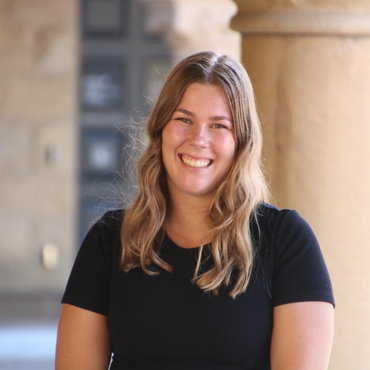
Sean Casey, ’23
Lobbying for an Election Day holiday
It was the most intense Zoom meeting of my life. My friend Jonathan Lipman and I were presenting to Stanford's Faculty Senate for the third (and hopefully final) time, and my heart was beating out of my chest. At stake was a proposal we called the “Day of Civic Service,” popularly known as an Election Day holiday.
Our idea, at its core, was a simple one. Stanford should recognize federal election days as academic holidays to give students the opportunity to cast a ballot, consider their electoral options, serve as poll workers, learn about the governments of other cities and nations, and broadly celebrate democracy in all its forms. The simplicity of the concept, though, belied the difficulty we'd faced in making this policy change a reality.
The Day of Civic Service began in a conversation I'd had with a pal last summer. I'd just become the co-director of StanfordVotes and was looking for ideas. The friend, Nik Marda, said that a good project might be to lobby Stanford to abstain from holding class on Election Day to promote voting, civic engagement, and participation. Students had been talking about the idea for a while now, and this year, with the 2020 election in a few short months, it might finally be possible to move the ball forward.
Nik connected me with an Associated Students of Stanford University (ASSU) senator he knew, Jonathan Lipman, and everything took off from there. On the advice of staff and faculty, particularly Matthew Tiews and Professor Adam Bonica, Jonathan and I wrote white papers and Op-Eds, shepherded the bill through the Undergraduate Senate and the Graduate Student Council, and, thanks to a helpful bylaw, put the calendar change proposal in front of the Faculty Senate by October. After the Senate sent the issue to two subcommittees—which, five months later, sent it back—we finally got the full proposal up for consideration at the end of spring quarter.
At the time, I had no idea which way the vote would go. It seemed like faculty were broadly supportive, but the devil was in the details, and God knows there were a lot of those. There were questions about make-up time, accreditation, programming, voting law, absentee ballots, the necessity of civic engagement, and the role of a university in the political life of its students.
We thought our argument was strong—and our cause just—but on some level, that might not be enough to move the needle. Maybe Stanford just didn't see itself as an institution that cared about democratic participation.
So, when I was sitting in that Zoom meeting, sweating furiously, I was as nervous as I've ever been. The first person to speak up after the presentation came out against it.
“That's bad,” I thought.
But the professor right after him said it was a great idea. Was that good? Did I catch a nod, perhaps? Or was that a head shake? Were folks paying too much attention, or not enough?

I was so stressed that when they called the vote and the parliamentarian said, "Proposal passes," I almost fell out of my chair.
Looking back, though, I shouldn't have been surprised. The signs were right in front of me all along.
That was because I'd not given Stanford enough credit. I think it's easy—all the way over here in California—to trick ourselves into thinking that we don't have much role to play in government; that the pathways to real change lie purely in tech, entrepreneurship, and STEM; and that, as a university, our mission is somehow divorced from the political systems in which we operate.
From a student perspective, it can be difficult to figure out how Stanford can help us make tangible changes to the way our government and our democracy function.
But through this experience, I learned that civic engagement can be as easy as finding something you're passionate about and chasing it. It demonstrated to me that Stanford is a place that prioritizes civic participation and seeks to educate global citizens, not just students.
Above all, this experience taught me that our university is still a place where great leadership—including to advance democracy—happens every day.


